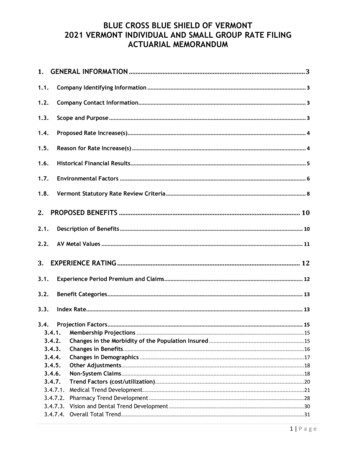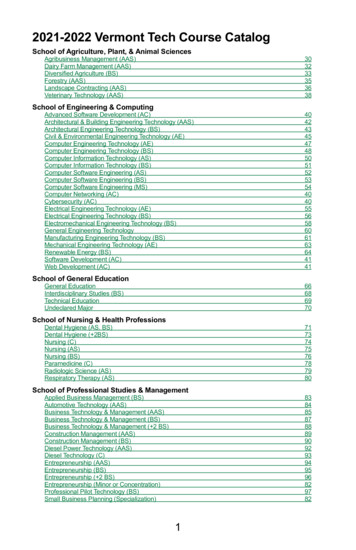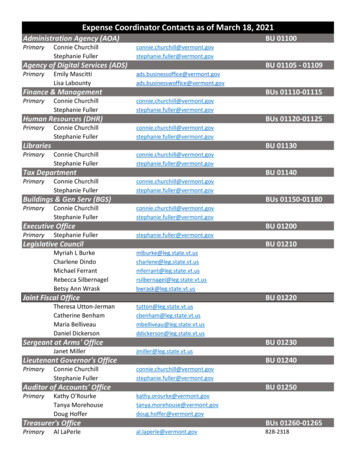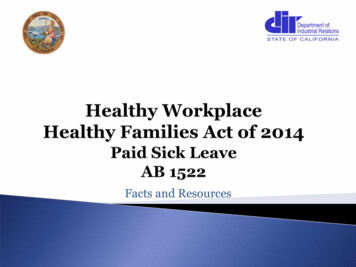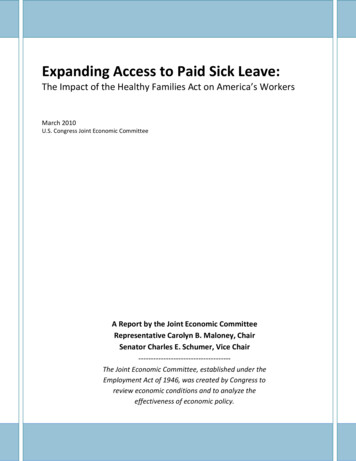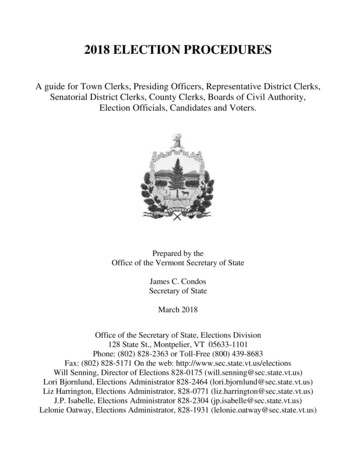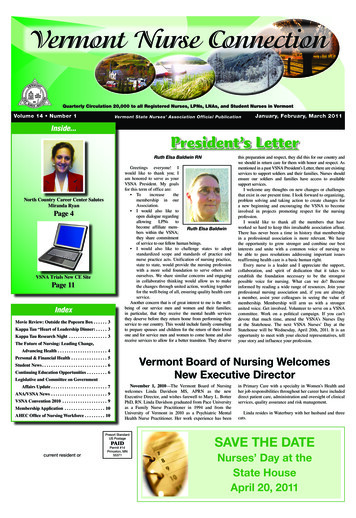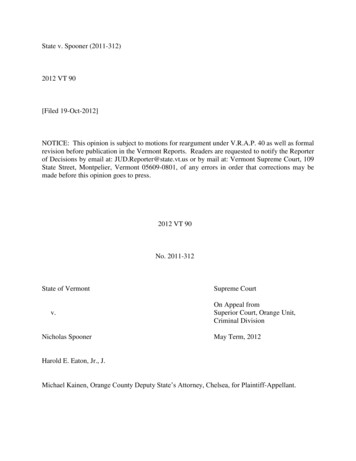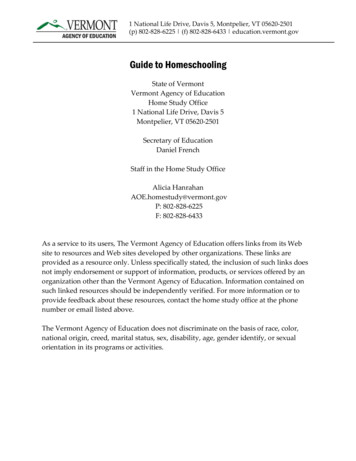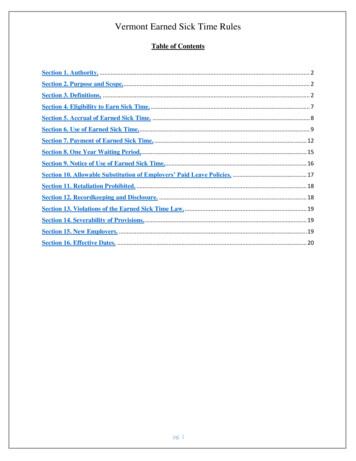
Transcription
Vermont Earned Sick Time RulesTable of ContentsSection 1. Authority. . 2Section 2. Purpose and Scope. . 2Section 3. Definitions. . 2Section 4. Eligibility to Earn Sick Time. . 7Section 5. Accrual of Earned Sick Time. . 8Section 6. Use of Earned Sick Time. . 9Section 7. Payment of Earned Sick Time. . 12Section 8. One Year Waiting Period. 15Section 9. Notice of Use of Earned Sick Time. 16Section 10. Allowable Substitution of Employers’ Paid Leave Policies. . 17Section 11. Retaliation Prohibited. . 18Section 12. Recordkeeping and Disclosure. . 18Section 13. Violations of the Earned Sick Time Law. . 19Section 14. Severability of Provisions. . 19Section 15. New Employers. . .19Section 16. Effective Dates. . 20pg. 1
Vermont Earned Sick Time RulesSection 1. Authority.This rule is issued by authority of the Commissioner of Labor pursuant to 21 V.S.A. § 487 andAct 69 of the 2016 General Assembly (“Act”).Section 2. Purpose and Scope.(a) Purpose. To clarify practices and policies in the administration and enforcement of “Anact relating to absence from work for health care and safety.” 21 V.S.A. §§ 481 - 486 (theAct).(b) Interaction with the Vermont Parental and Family Leave Act. Time accrued by anemployee may be used at the same time as time off provided by the Vermont Parental andFamily Leave Act. An employee may choose to use earned sick time as provided underthe Act to receive pay when taking leave under the Vermont Parental and Family LeaveAct that would otherwise be unpaid.Section 3. Definitions.As used in the Act, the following terms shall have the following meanings unless the contextclearly requires otherwise:(1) “Annual period” means any continuous 12-month period of time as determined by thefirst day of work. If an employee has been working before the implementation date of theAct, his or her annual period will start on January 1. An employer with an existing fixedpaid leave year may use such fixed paid leave year as the annual period, provided that allearned sick time accrued pursuant to the act shall be carried over into the fixed paid leaveyear. The use of approved off-payroll time does not restart the annual period and accrualof earned sick time shall resume upon the employee’s return to work.pg. 2
Vermont Earned Sick Time Rules(2) “Child” means a minor or adult son or daughter by birth or adoption.(3) “Commissioner” means the Commissioner of Labor or his or her designee.(4) “Discharge” means a separation from employment initiated by the employer, includinga temporary or seasonal layoff.(5) “Domestic Violence” has the same definition as in 15 V.S.A. § 1151.(6) “Earned Sick Time” means paid time off from work accrued by an employee andprovided by an employer for the purposes permitted by the Act.(7) “Employee” means any person who, in consideration of direct or indirect gain or profit isemployed by an employer for an average of not less than 18 hours per week. To calculateif an employee has worked an average of 18 hours per week an employer shall, on ayearly basis, divide the number of hours worked by the employee in the last completedcalendar year by 52. If an individual has been employed for an average of not less than 18hours per week in the prior calendar year, the individual’s accrual of sick time shall bedeemed to have commenced on the first day of that year. The previous calendar yearcalculation shall not be applied to those individuals hired during that calendar year whoare anticipated to work an average of more than 18 hours a week. The term “employee”shall not include:(A) an employee of the federal government;(B) an individual who is employed by an employer for 20 weeks or fewer in a 12month period and in a job scheduled to last 20 weeks or fewer. If the job extendspast 20 weeks, sick time accrual shall be deemed to have commenced on the firstday of work. The one year waiting period on the use of earned sick time may stillapply to the employee.pg. 3
Vermont Earned Sick Time Rules(C) an individual that is employed by the State and is exempt or excluded from theState classified service pursuant to 3 V.S.A. § 311, but not an individual that isemployed by the State in a temporary capacity pursuant to 3 V.S.A. § 331.(D) an employee of a health care facility as defined in 18 V.S.A. § 9432(8) or afacility as defined in 33 V.S.A. § 7102(2) if the employee only works on a perdiem or intermittent basis.(i) “Health care facility" means all persons or institutions, including mobilefacilities, whether public or private, proprietary or not for profit, whichoffer diagnosis, treatment, inpatient, or ambulatory care to two or moreunrelated persons, and the buildings in which those services are offered.The term shall not apply to any institution operated by religious groupsrelying solely on spiritual means through prayer for healing, and shallinclude but is not limited to:(aa)hospitals, including general hospitals, mental hospitals,chronic disease facilities, birthing centers, maternity hospitals,and psychiatric facilities including any hospital conducted,maintained, or operated by the state of Vermont, or itssubdivisions, or a duly authorized agency thereof;(bb)nursing homes, health maintenance organizations, homehealth agencies, outpatient diagnostic or therapy programs,kidney disease treatment centers, mental health agencies orcenters, diagnostic imaging facilities, independent diagnosticlaboratories, cardiac catheterization laboratories, radiationpg. 4
Vermont Earned Sick Time Rulestherapy facilities, or any inpatient or ambulatory surgical,diagnostic, or treatment center.(ii) "Facility" means a residential care home, nursing home, assisted livingresidence, home for persons who are terminally ill, or therapeuticcommunity residence licensed or required to be licensed pursuant to theprovisions of Chapter 71 of Title 33.(E) an employee of a school district, supervisory district, or supervisory union asdefined in 16 V.S.A. § 11 that:(i) is employed pursuant to a school district or supervisory union policy onsubstitute educators as required by the Vermont Standards Board forProfessional Educators Rule 5381; and(ii) is under no obligation to work a regular schedule; and(iii) is not under contract or written agreement to provide at least one period oflong-term substitute coverage which is defined as 30 or more consecutiveschool days in the same assignment.(iv) "School district" means town school districts, union school districts,interstate school districts, city school districts, unified union districts, andincorporated school districts, each of which is governed by a publiclyelected board.(v) “Supervisory district" means a supervisory union that consists of only oneschool district, which may be a unified union district.(vi) “Supervisory union" means an administrative, planning, and educationalservice unit created by the State Board of Education under 16 VSA § 261pg. 5
Vermont Earned Sick Time Rulesthat consists of two or more school districts; if the context clearly allows,the term also means a supervisory district.(F) an individual who is under 18 years of age.(G) an individual that is either:(i) a sole proprietor or partner owner of an unincorporated business who isexcluded from the definition of employee under 21 VSA § 601(14)(F); or(ii) an executive officer, manager, or member of a corporation or a limitedliability company for whom the Commissioner has approved an exclusionfrom the provisions of chapter 9 of Title 21, pursuant to § 601(14)(H).(H) an individual that:(i) works on a per diem or intermittent basis; and(ii) works only when he or she indicates that he or she is available to work;and(iii) is under no obligation to work for the employer offering the work; and(iv) has no expectation of continuing employment with the employer.(8) “Employer” means any individual, organization, or governmental body, partnership,association, corporation, legal representative, trustee, receiver, trustee in bankruptcy, andany common carrier by rail, motor, water, air or express company doing business oroperating within this state.(9) “Foster child” mean a foster child, a stepchild, a legal ward, or a child for whom anemployee has assumed the responsibilities of parenthood, and a child of an employeestanding in loco parentis, as defined by 29 U.S.C. § 2611(12) and 29 C.F.R. §§825.122(c) and 825.800.pg. 6
Vermont Earned Sick Time Rules(10)"Paid time off policy" means any policy under which the employer providespaid time off from work to the employee that includes a combination of one or more ofthe following:(i) annual leave;(ii) combined time off;(iii) vacation leave;(iv) personal leave;(v) sick time; or(vi) any similar type of leave.(11)“Sexual Assault” has the same definition as in 15 V.S.A. § 1151.(12)“Small Employer” means an employer who on January 1, 2017 has five or feweremployees who averaged 30 hours or more per week during the previous calendar year.Individuals working less than 30 hours per week shall not be counted when calculatingthe number of employees. A small employer is not subject to the requirements of the Actuntil January 1, 2018.(13)“Stalking” has the same definition as in 15 V.S.A. § 1151.Section 4. Eligibility to Earn Sick Time.(a) An employee is eligible to accrue and use earned sick time if the employee’s primaryplace of work is in Vermont, regardless of the primary location of the employer.pg. 7
Vermont Earned Sick Time Rules(b) If an employee is eligible to accrue and use earned sick time, then all hours the employeeworks shall be applied toward accrual of earned sick time regardless of the location of thework.1(c) An eligible employee who is permanently transferred to another state but remains withthe same employer will no longer accrue earned sick time but may use any sick timealready accrued.Section 5. Accrual of Earned Sick Time.(a) Between January 1, 2017, and December 31, 2018, an employee shall accrue earned sicktime on all hours worked at a rate of no less than one hour of earned sick time for every52 hours worked, including overtime hours, of which a minimum of 24 hours shall beusable per annual period.(b) After December 31, 2018, an employee shall accrue earned sick time on all hours workedat a rate of no less than one hour of earned sick time for every 52 hours worked,including overtime hours, of which a minimum of 40 hours shall be usable per annualperiod.(c) An employer may allow the accrual of additional earned sick time in excess of theminimum amount.(d) An employer shall not be required to track accrual balances in increments of less than onehour.(e) An employee exempt from overtime requirements under The Fair Labor Standards Act(29 U.S.C. § 213(a)(1)) shall be assumed to work 40 hours in each work week for1For example, in a single year, an employee of a Vermont catering company works 550 hours in Vermont, 350hours in New Hampshire and 200 hours in Maine. The caterer will accrue earned sick time on all 1,100 hoursworked for the catering company.pg. 8
Vermont Earned Sick Time Rulespurposes of earned sick time accrual unless the job worked specifies a lower number ofhours per week. In such cases, earned sick time shall accrue based on the specifiednumber of hours worked per week.(f) Adjunct faculty compensated on a fee-for-service or “per-course” basis shall be deemedto work 3 hours for each “classroom hour” worked.(g) An employer shall be in compliance with this section if the employer provides theemployee with at least the full amount of earned sick time required by subsections (a) and(b) of this section at the beginning of each annual period. If the employer provides anemployee with the full amount of sick time at the beginning of each annual period, anyunused earned sick time hours at the end of the annual period shall not carry over into thesubsequent annual period.(h) Except as otherwise provided in subsection (g) of this section and section seven of theserules, earned sick time that remains unused at the end of an annual period shall be carriedover to the next annual period and the employee shall continue to accrue earned sick timeat the same rate established in the Act. However, nothing in this subsection shall beconstrued to permit an employee to use more earned sick time during an annual periodthan any limit on the use of earned sick time that is established by his or her employerpursuant to the Act.Section 6. Use of Earned Sick Time.(a) From January 1, 2017, to December 31, 2018, an employee has the right to use up to 24hours of accrued earned sick time per annual period.pg. 9
Vermont Earned Sick Time Rules(b) Beginning January 1, 2019, an employee has the right to use up to 40 hours of accruedsick time per annual period.(c) An employee may use earned sick time for the following:(1) care for the employee’s own physical or mental illness, injury, or medicalcondition that requires homecare, professional medical diagnosis or care, orpreventative medical care, including diagnostic, preventive, routine, or therapeutichealth treatment;(2) care for the employee’s parent, grandparent, spouse, child, brother, sister, parentin-law, grandchild or foster child, who is suffering from a physical or mentalillness, injury, or medical condition that requires home care, professional medicaldiagnosis or care, or preventative medical care;(3) care for the employee’s sick or injured parent, grandparent, spouse, child, brother,sister, parent-in-law, grandchild, or foster child, including helping that individualobtain diagnostic, preventive, routine, or therapeutic health treatment, oraccompanying the employee's parent, grandparent, spouse, or parent-in-law to anappointment related to his or her long-term care. Routine healthcare treatmentincludes travel to and from an appointment, a pharmacy, or other location relatedto the purpose for which the time was taken.(4) arranging for social or legal services or obtaining medical care or counseling forthe employee or for the employee's parent, grandparent, spouse, child, brother,sister, parent-in-law, grandchild, or foster child, who is a victim of domesticviolence, sexual assault, or stalking or who is relocating as the result of domesticpg. 10
Vermont Earned Sick Time Rulesviolence, sexual assault, or stalking. "Domestic violence," "sexual assault," and"stalking" shall have the same meanings as in 15 V.S.A. § 1151.(5) care for a parent, grandparent, spouse, child, brother, sister, parent-in-law,grandchild or foster child, because the school or business where that individual isnormally located during the employee’s workday is closed for public health orsafety reasons. A “business” includes a care facility.(d) An employer is not required to pay earned sick time and the employee shall not becharged for the use of earned sick time if the employee is not scheduled to be at workduring the period of use.(e) If an employee's absence is shorter than a normal workday, the employee shall use earnedsick time in the smallest time increments that the employer's payroll system uses or thatthe employer's paid time off policy permits. Employers may limit the minimum use ofearned sick time to one hour.(f) An employer shall post notice of the provisions of the Act in a form provided by theCommissioner, and in a place conspicuous to an employee at the employer's place ofbusiness. An employer shall also notify an employee of the provisions of the Act at thetime the employee is hired.(g) An employer shall not require an employee to make up time off from work as a conditionof using earned sick time. However, an employee and employer may by mutualagreement arrange for the employee to work additional hours during the same pay periodto avoid the use of and payment for earned sick time.pg. 11
Vermont Earned Sick Time Rules(h) An employer shall not require an employee to find a replacement for the employee’sabsences for purposes authorized by the Act, including absences for professionaldiagnostic, preventive, routine, or therapeutic health care.(i) If an employee is absent from work for one of the reasons listed in subsection (c) of thissection, the employee shall not be required to use earned sick time and the employer willnot be required to pay for the time that the employee was absent if the employer and theemployee mutually agree that either:(1) the employee will work an equivalent number of hours as the number of hoursfor which the employee is absent during the same pay period; or(2) the employee will trade hours with a second employee so that the secondemployee works during the hours for which the employee is absent and theemployee works an equivalent number of hours in place of the second employeeduring the same pay period.(j) An employer may adopt a policy that requires an employee to use earned sick time for anabsence from work for a reason listed in subsection (c) of this section.Section 7. Payment of Earned Sick Time.(a) Earned sick time shall be paid on the same schedule and in the same paycheck as regularwages are paid. An employer shall not delay compensating an employee for earned sicktime.(b) An employer may pay an employee for any hours of unused earned sick time at the endof the annual period or when the employee leaves employment. If an employer chooses topay unused sick time at the end of an annual period, then the sick time that is paid outshall not carry over into the subsequent annual period.pg. 12
Vermont Earned Sick Time Rules(c) An employee who voluntarily separates from employment without good causeattributable to the employer shall forfeit all accrued earned sick time and any accruedearned sick time shall not transfer if the employee is subsequently hired by anotheremployer.(d) An employer is not allowed to interrupt insurance benefits for an employee during the useof earned sick time. Group insurance benefits shall continue during the period anemployee uses earned sick time at the same level and conditions that coverage would beprovided for normal work hours. The employer may require that the employee contributeto the cost of the benefits during the use of earned sick time at the existing rate ofemployee contribution.(e) If an employee is compensated on an hourly basis, the normal hourly rate means theamount that an employee is regularly paid for each hour of work.(f) If an employee receives different pay rates for hourly work from the same employer, thenormal hourly rate means either:(1) the wages the employee would have been paid for the hours absent during use ofearned sick time if the employee had worked; or(2) the blended rate, determined by taking the weighted average of all regular rates ofpay over the previous pay period, month, quarter or other established period oftime the employer customarily uses to calculate blended rates for similarpurposes.(3) Regardless of the method the employer elects to determine the normal hourly rate,the employer shall use a consistent method for all his or her employeesthroughout an annual period.pg. 13
Vermont Earned Sick Time Rules(g) If an employee is paid a salary, the normal hourly rate means the employee’s totalearnings in the previous pay period divided by the total hours worked during the previouspay period. For determining total hours worked during the previous pay period, anemployee who is exempt from overtime requirements under the Fair Labor Standards Act(29 U.S.C. § 213(a) (1)), shall be presumed to work 40 hours each week unless his or hernormal work week is less than 40 hours, in which case the normal hourly rate shall becalculated based on the employee’s normal work week. Regardless of the basis used, thenormal hourly rate shall not be less than the effective minimum wage established by 21V.S.A. § 384.(h) If an employee is paid on commission (whether base wage plus commission orcommission only), the normal hourly rate means the greater of the base wage or theeffective minimum wage established by 21 V.S.A. § 384.(i) For a tipped employee who ordinarily receives the tipped wage rate under 21 V.S.A. §384, the normal hourly rate means the non-tipped minimum wage rate established by 21V.S.A. § 384.(j) As used in this section, the normal hourly rate shall not include:(1) sums paid as commissions, drawing accounts, bonuses, or other incentive paybased on sales or production;(2) sums excluded under 29 U.S.C. § 207(e), including contributions irrevocablymade by an employer to a trustee or third person pursuant to a bona fide plan forproviding old-age, retirement, life, accident, or health insurance, and any otheremployee benefit plans; andpg. 14
Vermont Earned Sick Time Rules(3) overtime, holiday pay, or other premium rates. However, where an employee’sregular hourly rate is a “differential rate,” meaning a different wage rate paid forthe same work performed under differing conditions (e.g. a night shift), the“differential rate” is not a premium.Section 8. One Year Waiting Period.(a) A newly hired employee. An employee begins accruing earned sick time on the first dateof actual work. An employer may require a waiting period for a newly hired employee ofup to one year. During this waiting period, an employee shall accrue earned sick timepursuant to the Act, but an employer may prohibit the use of earned sick time until afterthe employee has completed the waiting period.(b) An existing employee. An employer may require for an existing employee on January 1,2017, a waiting period of up to one year. The waiting period shall begin on January 1,2017, and shall end on or before December 31, 2017. During this waiting period, anemployee shall accrue earned sick time but an employer may prohibit the use of earnedsick time until after the employee has completed the waiting period.(c) A small employer. A small employer need not comply with the Act until January 1, 2018.The waiting period for small employers shall begin on January 1, 2018, and shall end onor before December 31, 2018. During this waiting period, an employee shall accrueearned sick time but an employer may prohibit the use of earned sick time until after theemployee has completed the waiting period.(d) An employee who is discharged by his or her employer after he or she has completed awaiting period, and is subsequently rehired by the same employer within 12 months afterthe discharge from employment shall begin to accrue and may use earned sick timepg. 15
Vermont Earned Sick Time Ruleswithout a waiting period. However, the employee shall not be entitled to retain anyearned sick time that accrued before the time of his or her discharge unless agreed to bythe employer.(e) An employee who is discharged prior to completing his or her waiting period and issubsequently rehired by the same employer within 12 months after the discharge fromemployment, shall have the same time remaining in his or her waiting period as on thedate of discharge.2(f) An employee that voluntarily separates from employment after he or she has completed awaiting period, and is subsequently rehired by the same employer within 12 months afterthe separation from employment shall not be entitled to use previously accrued sick timeand may be required to begin a new waiting period unless waived by the employer.Section 9. Notice of Use of Earned Sick Time.(a) An employer may require an employee planning to use earned sick time to makereasonable efforts to avoid scheduling routine or preventive health care during regularwork hours, or to notify the employer as soon as practicable of the intent to take earnedsick time and the expected duration of the employee's absence.(b) An employer may require an employee to provide reasonable notice before using earnedsick time.(c) The notice required to be given for unforeseeable absences is what is reasonable underthe circumstances, recognizing that there are certain situations such as accidents orsudden illness for which advance notice might be infeasible.2For example, if a person worked for eight months and was laid off and rehired two months later he or she willonly have four months left until he or she has completed the waiting period.pg. 16
Vermont Earned Sick Time Rules(d) For multi-day absences, an employer may require notification of the expected duration ofthe leave from the employee or the employee’s surrogate (e.g. spouse, adult familymember or other responsible party), unless the circumstances make such noticeimpracticable.(e) An employer may require an employee to give notice in a manner the employeecustomarily uses to communicate with the employer for reporting absences or requestingleave.(f) An employee who is required to give notice shall specify that he or she is using earnedsick time.(g) An employer may require an employee to provide reasonable proof that the employee’suse of earned sick time is for one of the purposes allowed by the Act.Section 10. Allowable Substitution of Employers’ Paid Leave Policies.(a) An employer may have their own sick time or paid leave policies, as long as allemployees can use at least the same amount of leave, for the same purposes, under thesame conditions, and with the same job protections provided in the Act.(b) An employer may have different paid leave policies for different groups of employees, aslong as each policy meets the minimum requirements provided in the Act.(c) An employer that provides paid time off in amounts consistent with the Act that also maybe used as earned sick time shall not be required to provide additional sick time to anemployee.33For example, a sporting goods store provides its employees with 40 hours of paid vacation time that can also beused as earned sick time, consistent with the Act. Does the store need to provide any separate sick time? No. Thesporting goods store does not need to provide additional sick time, but the store would be well advised to notifythe employees that if they use all of their hours for vacation, there will be no additional paid sick time available.pg. 17
Vermont Earned Sick Time Rules(d) Nothing in these rules shall be construed to diminish an employer's obligation to complywith any collective bargaining agreement or paid time off policy that provides greaterearned sick time rights than the rights provided by the Act.(e) A collective bargaining agreement or paid time off policy may not diminish the rightsprovided by the Act.Section 11. Retaliation Prohibited.(a) An employer shall not discharge or in any other manner retaliate against an employeebecause:(1) the employee lodged a complaint of a violation of the Act;(2) the employee has cooperated with the Commissioner in an investigation of aviolation of the Act; or(3) the employer believes that the employee may lodge a complaint or cooperate in aninvestigation of a violation of the Act.(b) Notwithstanding subsection (a), an employer may discipline an employee for using his orher earned sick time for reasons not consistent with the Act.Section 12. Recordkeeping and Disclosure.(a) An employer shall keep true and accurate records of the accrual and use of earned sicktime pursuant to 21 V.S.A. § 393.(b) An employer shall maintain such records for a period of three years and shall providecopies within 10 days upon demand by the Commissioner. An employee who requests hisor her records shall be provided with a copy within 5 days and shall be allowed to inspectthe original paper or electronic records at a reasonable time and place.pg. 18
Vermont Earned Sick Time RulesSection 13. Violations of the Earned Sick Time Law.(a) An employer who violates 21 V.S.A. § 482 or § 483 shall be fined not more than 5,000.00 per violation.(b) An employee may file a complaint with the Commissioner in the manner prescribed bythe Commissioner. The Commissioner shall investigate and enforce any violations inaccordance with 21 V.S.A. § 342a.(c) In addition to recovery of earned sick time pay, the Commissioner may assess a civilpenalty of not more than 5,000.00 per violation.Section 14. Severability of Provisions.If any provision of these rules or the application of such provision to any person orcircumstances shall be held invalid, the remainder of these rules and the application of suchprovisions to persons or circumstances other than those as to which it is held invalid shall not beaffected thereby.Section 15. New Employers.(a) Notwithstanding any provision of the Act to the contra
long-term substitute coverage which is defined as 30 or more consecutive school days in the same assignment. (iv) "School district" means town school districts, union school districts, interstate school districts, city school districts, unified union districts, and incorporated school districts, each of which is governed by a publicly
